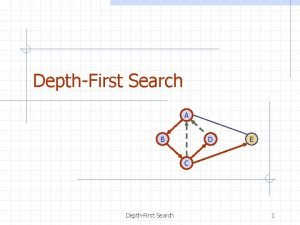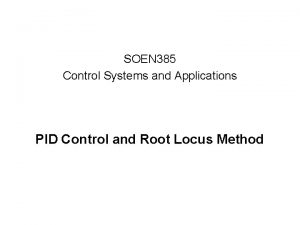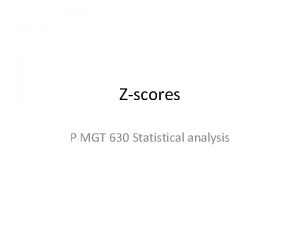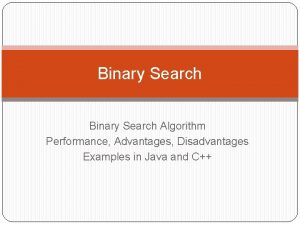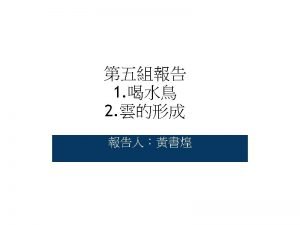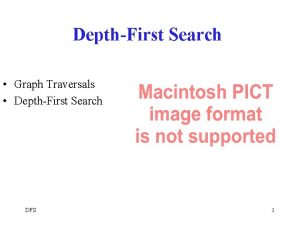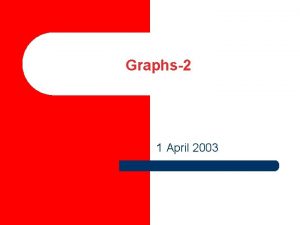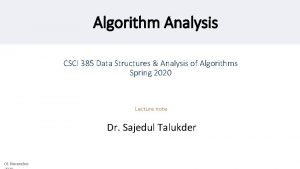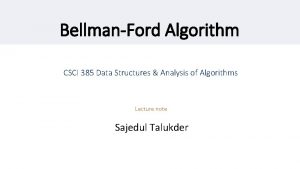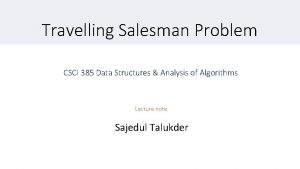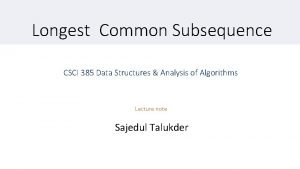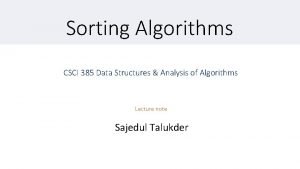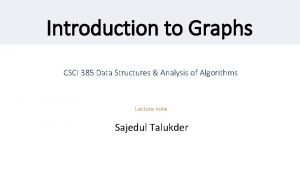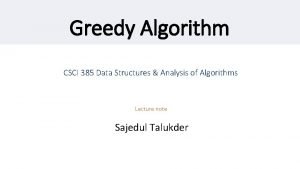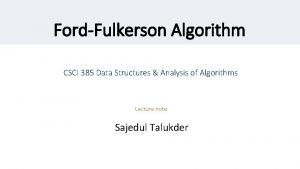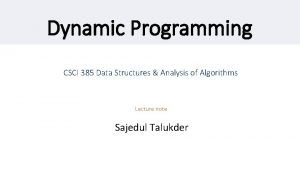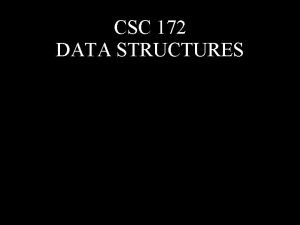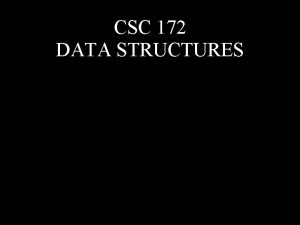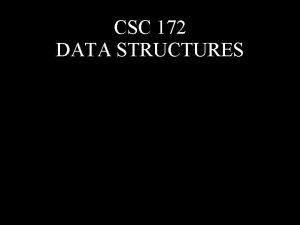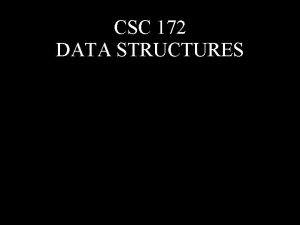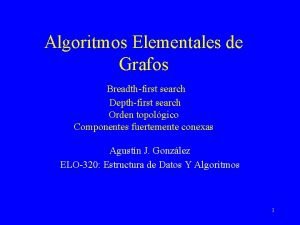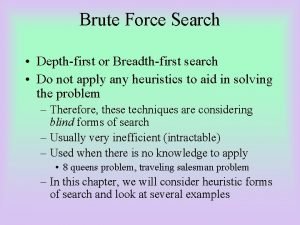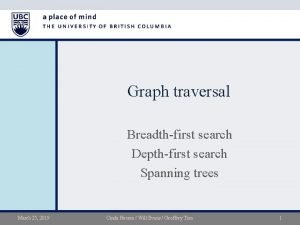Depthfirst search CSCI 385 Data Structures Analysis of




![DFS #include <iostream> #include <vector> using namespace std; vector <int> adj[10]; bool visited[10]; int DFS #include <iostream> #include <vector> using namespace std; vector <int> adj[10]; bool visited[10]; int](https://slidetodoc.com/presentation_image_h/e4791fef31550532b2e025a364753ac1/image-5.jpg)
![DFS #include <iostream> #include <vector> using namespace std; vector <int> adj[10]; bool visited[10]; int DFS #include <iostream> #include <vector> using namespace std; vector <int> adj[10]; bool visited[10]; int](https://slidetodoc.com/presentation_image_h/e4791fef31550532b2e025a364753ac1/image-6.jpg)






















- Slides: 28

Depth-first search CSCI 385 Data Structures & Analysis of Algorithms Lecture note Sajedul Talukder

Depth-first searching • Depth-First Search (DFS) A B C D E F H L M I N O G J P K Q • Searches down one path as deep as possible • When no nodes available, it backtracks • When backtracking, it explores side-paths that were not taken • Uses a stack (instead of a queue in BFS) • Allows an easy recursive implementation

DFS Algorithm • DFS can provide certain information about the graph that BFS cannot • It can tell whether we have encountered a cycle or not • DFS will continue to visit neighbors in a recursive pattern • Whenever we visit v from u, we recursively visit all unvisited neighbors of v. Then we backtrack (return) to u. • Note: it is possible that v 2 was unvisited when we recursively visit v 1, but became visited by the time we return from the recursive call to v. u w v v 1 v 2

DFS Algorithm Flag all vertices as not visited Flag yourself as visited For unvisited neighbors, call RDFS(w) recursively We can also record the paths using pred[ ].
![DFS include iostream include vector using namespace std vector int adj10 bool visited10 int DFS #include <iostream> #include <vector> using namespace std; vector <int> adj[10]; bool visited[10]; int](https://slidetodoc.com/presentation_image_h/e4791fef31550532b2e025a364753ac1/image-5.jpg)
DFS #include <iostream> #include <vector> using namespace std; vector <int> adj[10]; bool visited[10]; int nodes, edges, x, y, connected. Components = 0; void rdfs(int s) { visited[s] = true; cout << s << "->"; for(int i = 0; i < adj[s]. size(); ++i) { if(visited[adj[s][i]] == false) rdfs(adj[s][i]); } } void dfs() { for(int i = 0; i < 10; ++i) visited[i] = false; rdfs(i); } int main() { cout << "Number of vertices: "; cin >> nodes; //Number of nodes cout << "Number of edges: "; cin >> edges; //Number of edges for(int i = 0; i < edges; ++i) { cin >> x >> y; adj[x]. push_back(y); //Edge x, y adj[y]. push_back(x); //Edge x, y } dfs(); //Call the depth first search return 0; }
![DFS include iostream include vector using namespace std vector int adj10 bool visited10 int DFS #include <iostream> #include <vector> using namespace std; vector <int> adj[10]; bool visited[10]; int](https://slidetodoc.com/presentation_image_h/e4791fef31550532b2e025a364753ac1/image-6.jpg)
DFS #include <iostream> #include <vector> using namespace std; vector <int> adj[10]; bool visited[10]; int nodes, edges, x, y, connected. Components = 0; void rdfs(int s) { visited[s] = true; cout << s << "->"; for(int i = 0; i < adj[s]. size(); ++i) { if(visited[adj[s][i]] == false) rdfs(adj[s][i]); } } void dfs() { for(int i = 0; i < 10; ++i) visited[i] = false; for(int i = 1; i <= nodes; ++i) { if(visited[i] == false) { rdfs(i); connected. Components++; } } } int main() { cout << "Number of vertices: "; cin >> nodes; //Number of nodes cout << "Number of edges: "; cin >> edges; //Number of edges for(int i = 0; i < edges; ++i) { cin >> x >> y; adj[x]. push_back(y); //Edge x, y adj[y]. push_back(x); //Edge x, y } dfs(); //Call the depth first search return 0; }

Example Adjacency List 0 8 source 2 9 1 7 3 4 6 5 Visited Table (T/F) 0 F - 1 F - 2 F - 3 F - 4 F - 5 F - 6 F - 7 F - 8 F - 9 F - Pred Initialize visited table (all False) Initialize Pred to -1

Example Adjacency List 0 8 source 2 9 1 7 3 4 6 5 Visited Table (T/F) 0 F - 1 F - 2 T - 3 F - 4 F - 5 F - 6 F - 7 F - 8 F - 9 F - Pred Mark 2 as visited RDFS( 2 ) Now visit RDFS(8)

Example Adjacency List 0 8 source 2 9 1 7 3 4 6 5 Visited Table (T/F) 0 F - 1 F - 2 T - 3 F - 4 F - 5 F - 6 F - 7 F - 8 T 2 9 F - Pred Mark 8 as visited Recursive calls RDFS( 2 ) RDFS(8) 2 is already visited, so visit RDFS(0) mark Pred[8]

Example Adjacency List 0 8 source 2 9 1 7 3 4 6 5 Visited Table (T/F) 0 T 8 1 F - 2 T - 3 F - 4 F - 5 F - 6 F - 7 F - 8 T 2 9 F - Pred Mark 0 as visited Recursive calls RDFS( 2 ) RDFS(8) RDFS(0) -> no unvisited neighbors, return to call RDFS(8) Mark Pred[0]

Example Back to 8 Adjacency List 0 8 source 2 9 1 7 3 4 6 5 Visited Table (T/F) 0 T 8 1 F - 2 T - 3 F - 4 F - 5 F - 6 F - 7 F - 8 T 2 9 F - Pred Recursive calls RDFS( 2 ) RDFS(8) Now visit 9 -> RDFS(9)

Example Adjacency List 0 8 source 2 9 1 7 3 4 6 5 Visited Table (T/F) 0 T 8 1 F - 2 T - 3 F - 4 F - 5 F - 6 F - 7 F - 8 T 2 9 T 8 Pred Mark 9 as visited Recursive calls RDFS( 2 ) RDFS(8) RDFS(9) -> visit 1, RDFS(1) Mark Pred[9]

Example Adjacency List 0 8 source 2 9 1 7 3 4 6 5 Visited Table (T/F) 0 T 8 1 T 9 2 T - 3 F - 4 F - 5 F - 6 F - 7 F - 8 T 2 9 T 8 Pred Mark 1 as visited Recursive calls RDFS( 2 ) RDFS(8) RDFS(9) RDFS(1) visit RDFS(3) Mark Pred[1]

Example Adjacency List 0 8 source 2 9 1 7 3 4 6 5 Visited Table (T/F) 0 T 8 1 T 9 2 T - 3 T 1 4 F - 5 F - 6 F - 7 F - 8 T 2 9 T 8 Pred Mark 3 as visited Recursive calls RDFS( 2 ) RDFS(8) RDFS(9) RDFS(1) RDFS(3) Mark Pred[3] visit RDFS(4)

Example Adjacency List 0 8 source 2 9 1 7 3 4 Recursive calls 6 5 RDFS( 2 ) RDFS(8) RDFS(9) RDFS(1) RDFS(3) Visited Table (T/F) 0 T 8 1 T 9 2 T - 3 T 1 4 T 3 5 F - 6 F - 7 F - 8 T 2 9 T 8 Pred Mark 4 as visited Mark Pred[4] RDFS(4) STOP all of 4’s neighbors have been visited return back to call RDFS(3)

Example Adjacency List 0 8 source 2 9 1 7 3 4 6 5 Back to 3 Recursive calls RDFS( 2 ) RDFS(8) RDFS(9) RDFS(1) RDFS(3) Visited Table (T/F) 0 T 8 1 T 9 2 T - 3 T 1 4 T 3 5 F - 6 F - 7 F - 8 T 2 9 T 8 Pred visit 5 -> RDFS(5)

Example Adjacency List 0 8 source 2 9 1 7 3 4 Recursive calls 6 5 RDFS( 2 ) RDFS(8) RDFS(9) RDFS(1) RDFS(3) Visited Table (T/F) 0 T 8 1 T 9 2 T - 3 T 1 4 T 3 5 T 3 6 F - 7 F - 8 T 2 9 T 8 Pred Mark 5 as visited Mark Pred[5] RDFS(5) 3 is already visited, so visit 6 -> RDFS(6)

Example Adjacency List 0 8 source 2 9 1 7 3 4 Recursive calls 6 5 RDFS( 2 ) RDFS(8) RDFS(9) RDFS(1) RDFS(3) Visited Table (T/F) 0 T 8 1 T 9 2 T - 3 T 1 4 T 3 5 T 3 6 T 5 7 F - 8 T 2 9 T 8 Pred Mark 6 as visited Mark Pred[6] RDFS(5) RDFS(6) visit 7 -> RDFS(7)

Example Adjacency List 0 Visited Table (T/F) 8 source 2 9 1 7 3 4 Recursive calls 6 5 RDFS( 2 ) RDFS(8) RDFS(9) RDFS(1) RDFS(3) 0 T 8 1 T 9 2 T - 3 T 1 4 T 3 5 T 3 6 T 5 7 T 6 8 T 2 9 T 8 Pred Mark 7 as visited Mark Pred[7] RDFS(5) RDFS(6) RDFS(7) -> Stop no more unvisited neighbors

Example Adjacency List 0 8 source 2 9 1 7 3 4 Recursive calls 6 5 RDFS( 2 ) RDFS(8) RDFS(9) RDFS(1) RDFS(3) Visited Table (T/F) 0 T 8 1 T 9 2 T - 3 T 1 4 T 3 5 T 3 6 T 5 7 T 6 8 T 2 9 T 8 Pred RDFS(5) RDFS(6) -> Stop

Example Adjacency List 0 8 source 2 9 1 7 3 4 Recursive calls 6 5 RDFS( 2 ) RDFS(8) RDFS(9) RDFS(1) RDFS(3) Visited Table (T/F) 0 T 8 1 T 9 2 T - 3 T 1 4 T 3 5 T 3 6 T 5 7 T 6 8 T 2 9 T 8 Pred RDFS(5) -> Stop

Example Adjacency List 0 8 source 2 9 1 7 3 4 Recursive calls 6 5 RDFS( 2 ) RDFS(8) RDFS(9) RDFS(1) RDFS(3) -> Stop Visited Table (T/F) 0 T 8 1 T 9 2 T - 3 T 1 4 T 3 5 T 3 6 T 5 7 T 6 8 T 2 9 T 8 Pred

Example Adjacency List 0 8 source 2 9 1 7 3 4 Recursive calls 6 5 RDFS( 2 ) RDFS(8) RDFS(9) RDFS(1) -> Stop Visited Table (T/F) 0 T 8 1 T 9 2 T - 3 T 1 4 T 3 5 T 3 6 T 5 7 T 6 8 T 2 9 T 8 Pred

Example Adjacency List 0 8 source 2 9 1 7 3 4 Recursive calls 6 5 RDFS( 2 ) RDFS(8) RDFS(9) -> Stop Visited Table (T/F) 0 T 8 1 T 9 2 T - 3 T 1 4 T 3 5 T 3 6 T 5 7 T 6 8 T 2 9 T 8 Pred

Example Adjacency List 0 8 source 2 9 1 7 3 4 6 5 RDFS( 2 ) RDFS(8) -> Stop Recursive calls Visited Table (T/F) 0 T 8 1 T 9 2 T - 3 T 1 4 T 3 5 T 3 6 T 5 7 T 6 8 T 2 9 T 8 Pred

Example Adjacency List 0 8 source 2 9 1 7 3 4 6 5 RDFS( 2 ) -> Stop Recursive calls Visited Table (T/F) 0 T 8 1 T 9 2 T - 3 T 1 4 T 3 5 T 3 6 T 5 7 T 6 8 T 2 9 T 8 Pred DFS: 2 ->8 ->0 ->9 ->1 ->3 ->4 ->5 ->6 ->7

Example 0 Adjacency List 8 source 2 9 1 7 3 4 6 5 Check our paths, does DFS find valid paths? Yes. Visited Table (T/F) 0 T 8 1 T 9 2 T - 3 T 1 4 T 3 5 T 3 6 T 5 7 T 6 8 T 2 9 T 8 Pred Path (7) = 7 ->6 ->5 ->3 ->1 ->9 ->8 ->2

Time Complexity of DFS (Using adjacency list) • We never visited a vertex more than once • We had to examine all edges of the vertices • We know Σvertex v degree(v) = 2 m where m is the number of edges • So, the running time of DFS is proportional to the number of edges and number of vertices (same as BFS) • O(n + m) • You will also see this written as: • O(|v|+|e|) |v| = number of vertices (n) |e| = number of edges (m)
 Depthfirst search
Depthfirst search Analogous structures
Analogous structures 16-385 computer vision
16-385 computer vision Bentuk bilangan oktal dari bilangan desimal 385
Bentuk bilangan oktal dari bilangan desimal 385 Mgt 385
Mgt 385 Em 385 1 1 2014
Em 385 1 1 2014 Ece385
Ece385 Army accident classification
Army accident classification Soen 385
Soen 385 Ece 385
Ece 385 Xkcd 385
Xkcd 385 Fort polk dmv
Fort polk dmv 385 f to c
385 f to c Mgt 385
Mgt 385 Soen 385
Soen 385 459-393-385
459-393-385 Uninformed search methods
Uninformed search methods Federated search vs discovery
Federated search vs discovery èinterest
èinterest Federated search vs distributed search
Federated search vs distributed search What is informed search and uninformed search
What is informed search and uninformed search Images search yahoo
Images search yahoo Best first search is a type of informed search which uses
Best first search is a type of informed search which uses Heuristik
Heuristik Video.search.yahoo.com
Video.search.yahoo.com Yahoo search video
Yahoo search video Drawbacks of binary search
Drawbacks of binary search Search by image
Search by image Yahoo
Yahoo
